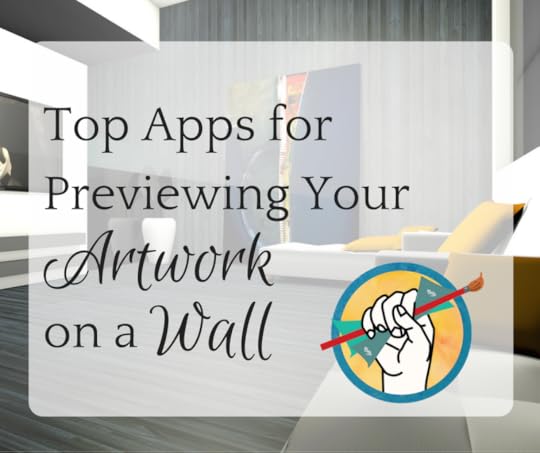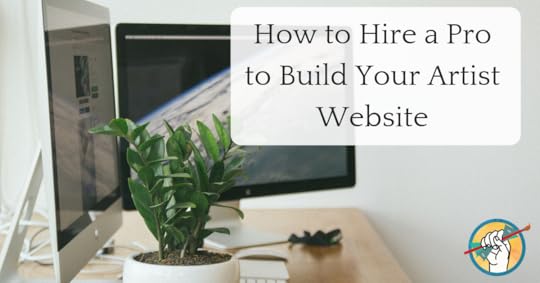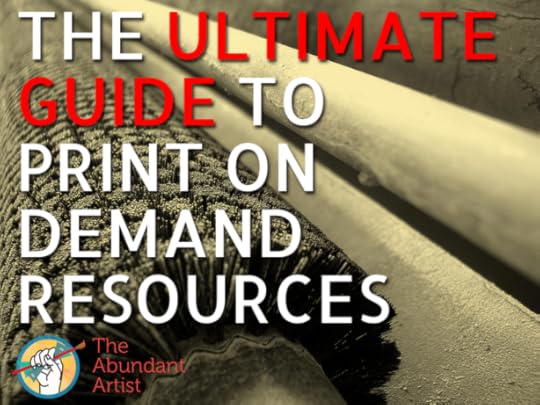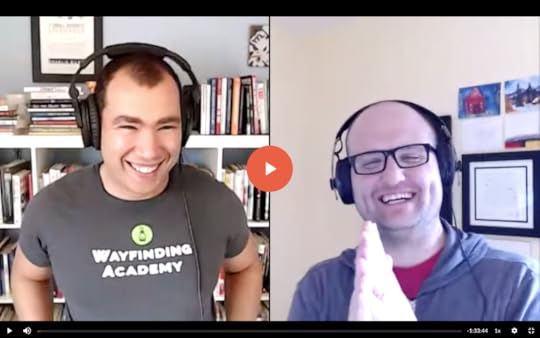Cory Huff's Blog: The Abundant Artist Goodreads blog, page 15
January 9, 2019
Basic Sales Skills: Seal the Deal With Body Language
Why does an artist need to know about body language?
If you’re an artist, and even more so if you are not represented by a gallery that is doing the selling for you, you need to know how to sell your own art. If you ever attend art fairs, art talks, or show your work in any public or private setting where other people are present (that is, pretty much every working artist in the world), you need to have an understanding of how body language can influence your potential customers’ interest in your work.
Vanessa Van Edwards, body language expert and founder of Science of People joined us for a podcast on how to sell more art by improving your body language. You can listen to the entire conversation here: How to Talk About Your Art (Even if You’re a Hopeless Introvert.)
We’ve condensed her talk with us down into a few body language basics that you can start improving right now.
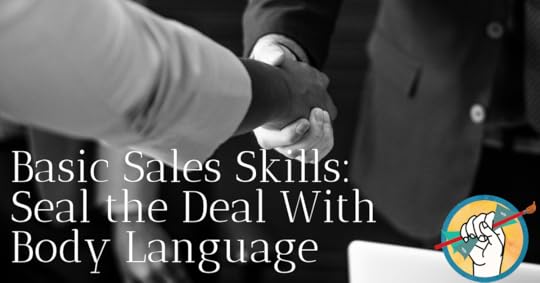
What Does Body Language Have to do With Selling?
It’s unlikely that you’re even aware this is happening, but within the first 1/10th of a second of encountering someone in a sales setting, you’ve already determined whether or not you’re willing to purchase from them. Their appearance, the way they carry themselves, and most of all their body language all send signals that your brain is wired to pick up very quickly. This rule is the same when the roles are reversed and you are the one trying to sell your art: if you are sending the wrong signals with your body language, you may be driving off potential customers.
“What’s important for artists to think about is your nonverbal brand. Your work has a brand in itself. It has a feeling, it has a message, but what does your nonverbal brand say? What do the pictures of you on your website say? What do you say when you’re standing next to someone with your clothes, your body language, your facial expressions, your voice tone?” -Vanessa Van Edwards
Not only could your current body language be turning off your potential collectors, but it could actually be increasing your cortisol levels. Cortisol is famously regarded as the “stress hormone”, and the position that an under-confident artist takes in their booth at an art fair: shoulders rounded in, chin down, legs crossed, etc, actually increases cortisol levels, which in turn make you appear to be less likable than you actually are.
“Cortisol makes us think slowly, it lowers our metabolism, it causes us to gain weight, it lowers our immune system. It’s the hormone that we do not want coursing through our bodies when we’re about to sell to a very big client or negotiate with so one. So when you’re sitting like that or standing like that in the very corner of your tent… you’re not only signaling people ‘I don’t feel confident in my work,’ but you’re also feeling less confident in your work because you have stress hormones coursing through your body.” – Vanessa Van Edwards
If you’re reading this and recognizing a description of your own body language, don’t get too worried. You can actually make yourself more approachable and appear more confident with a few simple body language tweaks.
How to Instantly Seem More Confident
The prescriptive antidote to the unconfident body language just described is the universal pride pose. It’s the universal pose used by athletes all over the world when they win a race. You can try it out right now:
roll your shoulders back
bring your chin, your chest and your forehead up
keep your arms and hands nice and loose by your sides
plant your feet at least hip-width apart
take a deep breath in as if you’re trying to expand or inflate your body.
How does it feel? When Cory tried it, he said he felt instantly more powerful. And with good reason: within five minutes, this pose actually reduces cortisol levels and increases the release of the body’s strength hormone, testosterone (although it’s primarily identified as a male hormone, testosterone is present in both males and females).
“Instead of seated hunched over or with your arms tightly pinned, I want you to actually think about inflating your body as you stand there. Get a bigger chair with armrests so you can have your arms on them. Sit tall, or stand tall in the back. Don’t feel like you have to give them space to look at your work. They have enough space to look at your work. Roll your shoulders back, keep your hands and arms nice and loose, and have your feet firmly planted. When you do this, you are not only signaling to them, ‘I am competent and confident,’ but you’re also signaling to yourself that you are confident and competent.” – Vanessa Van Edwards
What about Personal Space?
Regarding personal space, there is a general rule of thumb about how much space to give another person depending on the context. The science of personal space, called proxemics, determines that 6 inches from one’s face is intimate space, usually reserved for a romantic partner. Social space, a friendly chat between friends or acquaintances, is about a foot and a half apart. In the close proximity of an art space, which may not allow room for more distance between you and potential customers who don’t know you, the rules change. The most important thing is to respect the 6-inch rule. Moving in closer than 6 inches creates a tension in the amygdala of your customers’ brain, and they will be unable to focus on evaluating your art and deciding whether or not to purchase (in other words, you’ve definitely lost the sale.)
Providing too much space, on the other hand, doesn’t signal that competent confidence that you want to exude. Be sure to cross into the foot-and-a-half or so of social space and lean in a little.
Do I Have to Become an Extrovert?
This is the next big question asked by artists who identify as introverts. Do you need to change who you are on a fundamental level just to sell your art? The answer is a resounding no! You can exude confidence without being an extrovert. As Vanessa Van Edwards puts it,
“ Everyone should have their own unique brand of charisma. For you that might be a kind of quiet power. For someone else it might be a kind of bubbly extroversion. Whatever that is, there are tools, nonverbal tools that you can learn and adapt, so you practice them and they turn into muscle memory.”
Once you know your unique value proposition, using an increased awareness of your body language to portray a sense of confidence and competence will drastically increase your chances of selling your art in person whether it’s in a gallery, at a show or art fair, or in a potential collector’s home. If you’d like to learn more about how to expand your business and interpersonal skills with better body language, you can check out Vanessa’s courses at her website: Science of People.
The post Basic Sales Skills: Seal the Deal With Body Language appeared first on Online Marketing for Artists.
January 4, 2019
Member of the Week: Gwen Meharg, Using Abstraction to Paint Hope
We’re excited to bring a new weekly feature to the blog: each week we’ll be highlighting a new member of The Abundant Artist Association. Our members have graciously answered our questions about their art practice and business and we’re looking forward to sharing their wisdom and experience with you over the coming weeks.
Our first member is abstract artist Gwen Meharg.
TAA: How would you describe your art to your ideal collector?
Gwen: I use abstraction to paint hope. Hope is what lingers after the ugly and difficult. The layers, some of them not pretty, represent moments of time frozen for examination. A moment in time, be it seen or unseen, is still true. I wrestle with the paintings until they resolve into beauty. The paintings are a reflection of who I am and also my religious tradition that offers hope that, in the end, each journey resolves in beauty.
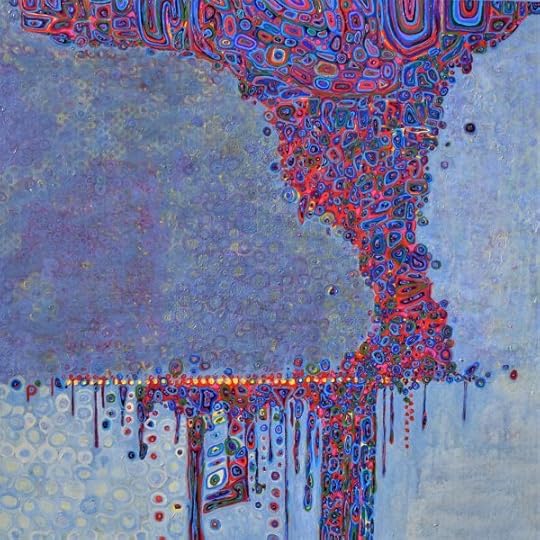 “Family Time Balance Series”, Gwen Meharg
“Family Time Balance Series”, Gwen Meharg
TAA: What motivates you during slow seasons?
Gwen: Sheer determination and stubbornness. Motivation has to come from within. Anything else is a game. BUT as far as games go, a crituqe and/or accountability group helps. Not wanting to disappoint, not wanting to be the dead weight, helps keep the people pleaser in me going.
For over ten years I attended two different in-person critique groups. It was hard. I had six children and traded for babysitting. What was interesting was how my kids got into it. “Mom, have you finished your paintings? How many?” “You better do your work.” They were merciless and enjoyed it!
One group allowed up to four paintings, the other three. I wanted my money’s worth so that meant seven paintings a month. I was working smaller and more direct then but it still took me twenty hours a week to get the paintings finished. Today, I could not make seven paintings a month, but those years of seven paintings a month instilled discipline in me. Now Ithe TAA community and an online artist accountability group keep me going focused when things are slow. Our time is precious. I do not want to waste anyone else’s time by my lack of diligence.
And after 29 years of stubborn determination, I am seeing some fruit. Sales are still elusive, but I have an opening scheduled January 1 at a high-end bed and breakfast in Fort Worth, Texas and a solo show at Pardieu Gallery in April and May in Allen, Texas.
PS. In the past I allowed my parent’s and sibling’s drama to derail me. The Big Leap was instrumental in breaking that destructive cycle. When my father died in October 2018 I learned I was ” intentionally disinherited”. I was shocked to learn it was a seven-figure loss. WIth the tools I am learning from The Big Leap, I watch the drama from afar rather than being sucked in. I have the rare privilege of knowing the cost of my freedom and for the first time in years, I sleep at night.
 “Dreaming in Blue”, Gwen Meharg
“Dreaming in Blue”, Gwen Meharg
TAA: How did you settle on your current way of working? (How did you narrow your focus?
Gwen: There has always been a spiritual theme to my work. Faith/prayer drew me back into art after my life as a software engineer. (I majored in computer information systems and statistics at university. Twice. I have an MBA.)
An abusive misogynist pastor and serious illnesses among friends left me without words to pray. Instead, I painted my prayers. Painting twenty hours a week, using abstraction, I thought I was doing something new. It turned out the heart of the paintings remained the same. A narrative of hope just shone through. I capitulated to the fact that I can’t escape who I am. Life is complicated, layered, I want to uncover the ribbon of hope.
I paint beautiful, maybe not pretty, but beautiful paintings. I read once that looking at a painting for three hours actually grown synapses in the brain. I want to make art to grown synapses. I want to grow brains and hope.
I work in series. I can look back to the mid-1980s and see the roots of where I began in my work today. Each year between Christmas and New Years I create a painting that challenges what has gone before and explores what might be. This determines my focus for the next year.
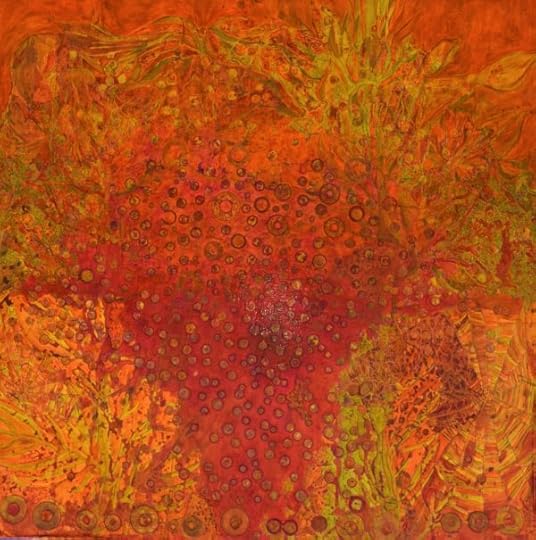 “Carpenter Ants & Red Cypress”, Gwen Meharg
“Carpenter Ants & Red Cypress”, Gwen Meharg
TAA: What is one mistake you’ve learned an important lesson from in your business?
Gwen: I really want to cuss here. Comparing one’s self to the successes and/or perceived successes of others is detrimental in art, art business, and life.
Compete, sure, but compete WITH not AGAINST. Competing with allows room for multiple successes and personal growth. Competing against creates losers. Art is a personal growth career. There is work to be done. Study. Learn. Grow. Be wise. But, guard against comparisons.
Not all artists will earn their livings from their art. NOT earning your living through your art does not mean you are not an artist. I believed that for decades. I am thankful for the changes in the art market that are making room for more of us. But still, financial success does not make you a great artist. Do what needs to be done to take care of yourself and your family and make art. You are not a lesser artist because you are fiscally responsible. Hooray for those who bring in a living wage through their art. Hooray for those who earn a living wage and make art.
We need to see each other and support each other. I guess I need to give this more thought, but until then, here ya go.
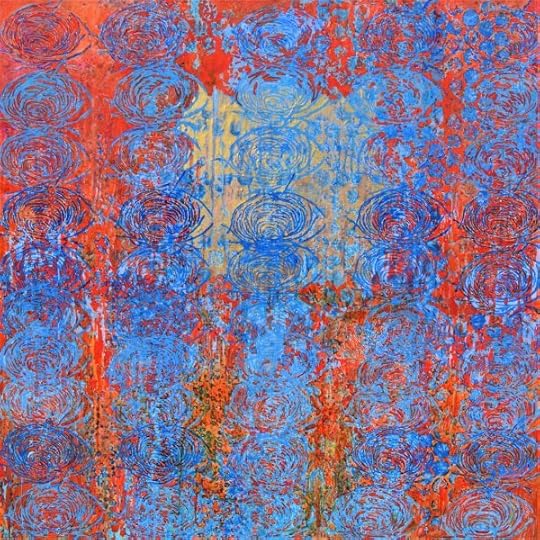 “Fifty Empty Nests”, Gwen Meharg
“Fifty Empty Nests”, Gwen Meharg
TAA: What was your greatest success from the past year?
Gwen: This is going to sound lame, but I did a review of the past year yesterday and was SHOCKED at the successes. I have stubbornly refused to plan since 1982. Five, ten and twenty-year plans were the rage when I was in business school. It freaked me out and I refused. That bled over into my art career. But in 2018, I risked a little planning. So my greatest success in 2018 was recording and acknowledging my successes, small and large.
I created goal boxes (NOT PLANS!) on four pages that I glued into my calendar. Four exhibition boxes. Twenty-four blog boxes. Twelve email boxes. Twenty-four art excursion boxes. Three gallery boxes. Twelve art-related travel boxes. Four art consultant boxes. You get the idea. I will not tell you the names of the ones where I checked off NO boxes. They had to do with personal care. Sigh.
Looking over those pages yesterday, I was THRILLED to see how many boxes I checked off. And I had to add boxes to exhibitions in 2018 (seven!) I had forgotten about most of them. You know how it is. You do the work and move on.
Maybe in 2019, I will learn to pause and celebrate before moving on. Enjoy the wins. Spend less time looking at what might have been. Check off some personal care boxes. I am going to be nice to me. Treat myself as kindly as I treat strangers. (But not drivers who cut me off. Nope, those losers….)
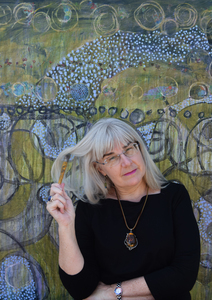
Gwen Meharg is an abstract painter based in Fort Worth, TX. You can see her work at http://gwenmeharg.com.
The post Member of the Week: Gwen Meharg, Using Abstraction to Paint Hope appeared first on Online Marketing for Artists.
January 2, 2019
Escaping Art World Camelot
Happy New Year and WOW, I’m so impressed at how many responses I received in our previous email about Camelot. There are a lot of fellow mythology nerds out there, and I appreciate your input! 
Basic Sales Skills: Your Unique Value Proposition
During the month of January we’re going to be doing an overview of some basic sales skills every professional artist needs to master. Because like it or not, if you hope to make a living from your art, you’re going to need to know how to sell it.
What exactly is it you’re selling, though? Is it just the physical painting, print or sculpture? Or is it something a little more abstract?
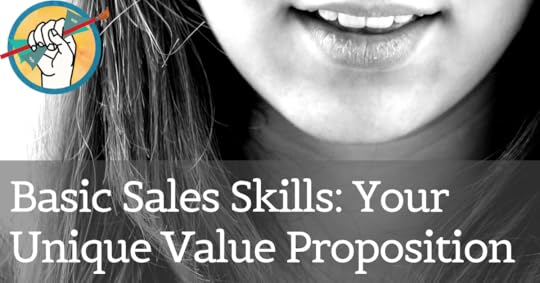
What is a Unique Value Proposition?
Every item that you purchase comes with a value proposition. Ann Rea, who made a six-figure income during her first year in business, explains it this way:
“Being able to define and evaluate what unique value you offer to a particular market.”
Ann Rea is known for painting vineyards. Her unique selling proposition is the unique celebration of the beauty of wine country in an authentic way, as appreciated particularly by enthusiasts of both wine and art.
The secret, for Ann Rea, is color inspired by natural light. She has selected a very specific demographic which defines her market.
Do I Really Have to Limit Myself to One Thing?
A common reaction to the idea of a unique value proposition is this:
“I can’t stand the thought of limiting my art!”
But this couldn’t be further from the truth. Rather, a unique voice with an identifiable look and feel is a basic requirement for a successful art career. If a collector can’t glance at your work and immediately tell who made it, you may have a problem. Let’s consider a famous example of a unique value proposition: Andy Warhol. Why was Warhol so successful?
Andy Warhol was successful due to his strong, uniquely recognizable voice in conjunction with a very specific strategy: celebrating celebrities. He made portraits of celebrity icons and was a master of PR.
How Do I Figure Out My Unique Value Proposition?
Figuring out your unique value proposition is a process that requires you to explore several questions about yourself, your art, and especially about your collectors.
Ask yourself:
What is unique about your art?
Why should anyone care?
Who are you trying to reach with your art?
Why will someone buy your art? (Is it to fill an emotional need? To make a statement? Something else?)
Ultimately, your unique value proposition is a combination of what you create and what your collectors get out of it. Following this formula, Ann Rea creates unique paintings of vineyards which provide a beautiful and authentic celebration of winemaking for wine and art lovers. You can work through the bulleted questions above until you’ve got an answer that feels authentic to you and your work, and that can really help you sell your art to the people who want it.
Want to learn more?
Listen to our entire conversation with Ann Rea, with a much more in-depth discussion of how she made six figures during her first year in business.
Take a deep dive into discovering your uniquity with How to Sell Your Art Online 101.
The post Basic Sales Skills: Your Unique Value Proposition appeared first on Online Marketing for Artists.
December 26, 2018
5 Ways to Make Your Online Art Store Stand Out
As we enter a new year, you may be thinking about new ways to make your business stand out. An easy way to get a leg up on the new year is to make sure your website is updated and reflecting your unique perspective with professionalism. There’s no need to get caught in the weeds with tiny inconsequential website tweaks when your time could be better spent on marketing (this is an easy trap for artists to fall into), but here is a short list of changes worth making to help your online art store stand out in the new year.
1. Entice collectors with images of your art in situ.
There are a ton of apps for previewing your art on a wall that allow you to show how your work would look in a room. Use these to add some variety to your images and help customers visualize what your art would look like on their walls.
2. Have killer copy.
Is your website copy a little lackluster? Breathe fresh life into your website, and even increase your chances of a sale, with awesome product descriptions for your art that reflect your vision and your personality.
3. Pay attention to branding.
Is your branding cohesive? Are the colors and fonts on your website representative of your brand as a whole? Artist Websites That Sell can help you make sure your website is doing everything it can to help you sell your art.
4. Hire a pro to design it.
If your website is in need of a redesign and web design isn’t currently among your skills, rather than spending potentially dozens or hundreds of hours to develop the skills necessary, why not hire a tech pro to design it for you and spend your valuable time on your art and marketing.
5. Integrate a POD feature.
If selling prints or other products on demand is part of your business model, several print-on-demand sites offer widgets, plugins, and functionalities to enhance your customer’s ability to purchase directly on your site.
As you review the past year and set goals for the next, what’s one productive change you can make to your online art store? Let us know in the comments!
The post 5 Ways to Make Your Online Art Store Stand Out appeared first on Online Marketing for Artists.
December 19, 2018
How to Write Awesome Product Descriptions for Your Art
What does a product description accomplish? Doesn’t your art speak for itself? Sure, a picture is worth a thousand words. But when you’re trying to sell that picture for cash, you may need a few extra words to get your point across. The key lies in using the right words to convince your potential collectors to click that Buy Now button. A little SEO know-how and careful thought beforehand will help your product descriptions do some of the heavy lifting of selling your art online.
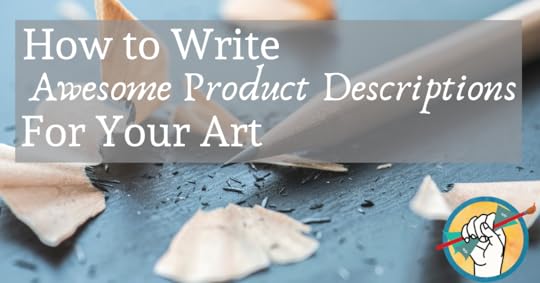
SEO basics
Search engine optimization is a tricky game to play, and for most artists working on developing a following online, it’s going to be somewhat optional. By this point, Google is quite wise to every trick in the book that website owners have tried to make their pages rank higher. If you’re hoping to gain some web traffic from search engines, an understanding of SEO basics is helpful for writing your product descriptions, but because you should also have strong social media and in-person presences that direct fans to your website, you shouldn’t be relying on SEO to bring in traffic. And it especially shouldn’t be obvious in your description that you’re trying to rank for certain keywords. Savvy internet users can smell keyword-stuffing from a mile away and it’s a major turn off.
These keyword tips are especially helpful for creating descriptions for listings on third-party websites like Etsy.
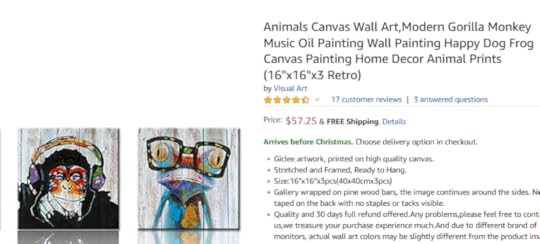
A keyword-stuffed title on Amazon.
Keywords
Pick one or two keywords or phrases that customers searching for art like yours may search for. “Charcoal forest drawing”, “retro pinup watercolor”, etc. Use these key phrases sprinkled naturally throughout your product description in places where it makes sense, and no more than 2 or 3 times.
Product title
The product title should include your keyword. It’s useful to include the name of the piece as well. “Charcoal Forest Drawing, ‘Serenity’, 12”x12” gives just enough information along with the thumbnail image of the piece to pique curiosity. If the title is too long, your customer’s eyes will glaze over and they won’t read it, potentially missing out on important information. Keep it short and sweet, and save the details for the description.
Careful not to over-optimize
Keyword-stuffing, as mentioned above, will hurt your Google ranking and also turn off potential customers. It looks like you either don’t know what you’re doing, or don’t care. So instead of “Black charcoal forest drawing woods scene chalk art original wilderness artwork”, settle on a single effective keyword or phrase and use it carefully.
Describing your art
Check out our helpful top-10 post on how to describe your art to the average person.
Focus on the colors, mood, and imagery. Specifically, try to view your art through the eyes of an enthusiastic collector. What is it that compels them to want to own your art? Is it just because it’s pretty, or is it because it reminds them of a beautiful childhood memory or evokes an emotion? Appeals to emotion and nostalgia are powerful sales tactics; look for them the next time you watch a commercial on YouTube or view an ad on Facebook.
Notable features
Think about aspects of the piece that your customers may find fascinating. Some aspects to consider:
Is there a special or funny story behind the piece?
Did it take an exceptionally long time or large number of steps to make?
Did you use special or unusual materials or source them from a special place?
Is there anything special or remarkable specifically about the subject of the piece?
The truth is that you aren’t just selling art- you’re selling your story. And each piece of art has a story too. It doesn’t have to be a long story or outrageous to be interesting to your collectors. This is why it’s helpful to journal as you create your art, so you can capture those interesting tidbits that you experienced along the way. (If you’re having trouble figuring out how to tell your story, HTSYAO 101 is a great place to start.)
Put yourself in the customer’s shoes
Consider what kind of experience a potential collector is seeking. As mentioned above, perhaps it’s a particular memory or feeling. Or perhaps they’re seeking a large statement piece that says something about themselves. Whatever it is, if you can dial in on the experience your collectors are seeking and appeal to that desire in your description, you have a higher chance of making the sale. Think about ways to describe:
How it feels to own this piece.
What effect it has on the room it’s hanging in and on the viewer each time they view it.
How can it make someone’s life better.
Once you get going, you may find that you have more to say than you thought. If you’re concerned about the length of the description, try separating it into tabs or headlined subsections that are easy to scan, like “How Was It Made?”, “The Story Behind This Piece”, etc.
Examples of great art descriptions
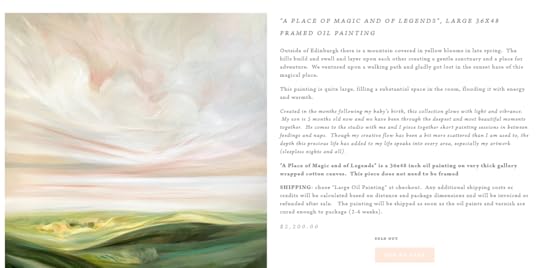
This description may be wordier than you’re ready to attempt, and that’s okay. This is what works for Emily Jeffords. She includes an enchanting description of the real landscape the painting is based on, how it appeals to the customer and how it will make them feel (flooding the room with energy and warmth), and the story behind this particular series of works. Her keyword is oil painting, and it’s used strategically just a few times, including in the title. Nailed it!
In contrast, here are a couple of more sparsely-worded descriptions that achieve a similar effect:
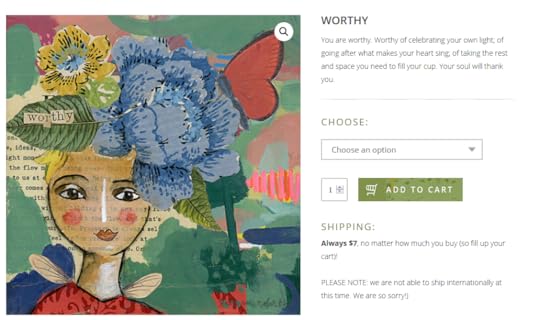
Kelly Rae Roberts is appealing to her collectors’ desire for a healthy sense of self-worth. The abstract collage nature of her work doesn’t necessarily warrant an explanation of the imagery, rather the spirit and intent behind it. This is something she accomplishes well, and with effective brevity.
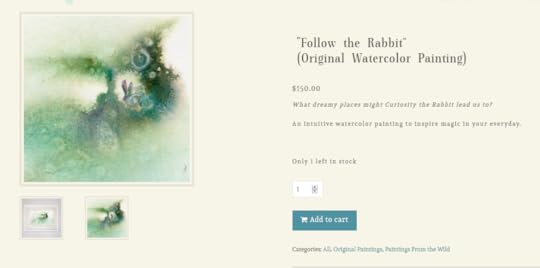
Amy Twon’s description is incredibly short, but it matches the dreamy, ethereal and mysterious quality of her work and intrigues the buyer. It also explains just a bit about the process of the painting (intuitive) and shares how it can make the collector’s life better (inspire magic in your everyday).
The key that makes all of these descriptions effective is a very clear understanding of what their collectors are looking for, and appealing to those desires with a carefully thought out description that reflects the best qualities of their art: whether those qualities are warmth, affirmation, or mystery.
Putting it all together
As you work out the best description that fits your artwork and your business, try this simple formula. Feel free to remove or add elements as needed, but remember that the product page should at a bare minimum list the title, materials, size, price, and shipping cost.
Title
Description or story behind the subject
Description or story behind the larger series
How will owning it make the collector feel?
Materials, size
Price + shipping
What story elements do you include in your product descriptions? Have you found it helpful to include those story bits, or are you having trouble with it? Let us know in the comments!
The post How to Write Awesome Product Descriptions for Your Art appeared first on Online Marketing for Artists.
December 12, 2018
How to Name Your Online Art Store
You’ve put in all the work of researching your target market and preparing to sell your artwork, not to mention the intense and emotional effort of actually creating the art. As inconsequential as a store name can feel in light of all your hard work, your store name can either give you a serious leg up or completely kneecap your ability to grow your business.
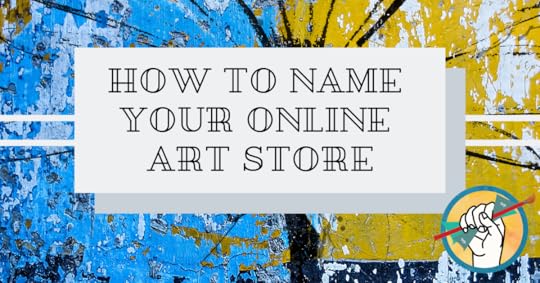
Why is your online art shop’s name important?
A great art shop name will stand out and be easy to remember and provide at least a hint of what kind of art you sell. Naming your shop something too generic will make it difficult for your site to rank in Google, while a name that is very odd may be off-putting or too hard to remember.
The trick lies in finding the sweet spot somewhere between search friendly and daringly unique. The great news is that in contrast to other kinds of online eCommerce businesses, as an artist you have a little extra leeway to be creative, since creativity is quite literally what is expected of you.
Here are the key points to keep in mind as you develop a great name for your online art store, whether you’re using a 3rd party platform like Etsy or your own website.
Keep it simple.
This is the most important thing to remember. Domain names can be around 60 characters, but your store name should be shorter than that. The name should be easy to say, type, and read. This is where artist websites will differ from other online shops: the URL itself in most cases should be your name. Most artist brands are built on their own name, and it makes it much easier for people to find you online. Your shop name, however, may differ from the URL and can still be a useful way to brand yourself and set your work apart.
There is nothing wrong with simply titling your shop “First Name Last Name Art”, but if you decide to get more creative, keep the following things in mind:
Research relevant keywords.
Do some keyword research for common searches relevant to the kind of artwork you sell, and think about how to incorporate them into your store name in a natural way.
Keywords you can consider including: the kind of medium you use (watercolor, charcoal), the genre of art you make (pop art, impressionist), the specific subject you focus on (oceans, horses, abandoned buildings). You can also get a little more abstract and think about the feeling your art invokes. Is it unsettling, spiritual, or ethereal?
Compare your top choices with existing store names
After you’ve done some keyword research and narrowed down a list of ideas, research similar stores and find out what names are already in use for stores selling products like yours.
Something too close to another store name will be confusing. If you have your heart set on “Pastel Portrait Boutique” but in your research you discover that there’s another shop selling under the name “The Portrait Boutique”, you are going to want to run far away from that name. Your business name is a chance to stand out from the crowd, not to sound exactly like everyone else. No busy artist wants to spend half their time correcting confused customers.
Pay attention to all your selling platforms.
Be sure to include social media in your search. Even if you don’t plan to have any presence on those platforms, as you gain traction it’s likely that customers will look for you there. You want to ensure another artist isn’t using a very similar name for their art page or business account.
A great art store name will make it easier for new collectors for find you. It will also make it easier for them to remember you, and to recommend you to others. The most important key points to remember as you consider name options are to keep your store name on the side of short and simple, consider including a relevant keyword to make it clear what kind of art you sell, and make sure that it’s unique enough to set you apart. Selecting a shop name doesn’t have to be stressful! Put the same thoughtfulness and creativity into building your online store as you do into creating your art and you’re sure to land on something memorable.
Does your store have a unique name, and has it made a difference for you? Share with us in the comments!
The post appeared first on Online Marketing for Artists.
December 4, 2018
Top 7 Artist eCommerce Shops
What makes a great artist eCommerce shop? Although awesome art is a great start, if your shop is hard to find, hard to navigate, and difficult to buy from, even the most beautiful art will languish unpurchased. We took a look at the shops of a few of our favorite artist websites to find out what they’re doing well, and how you can emulate them with our own eCommerce shop. There are examples here of shops running on both Squarespace and WordPress. Regardless of the platform you use, the principles of what makes a great shop are the same.
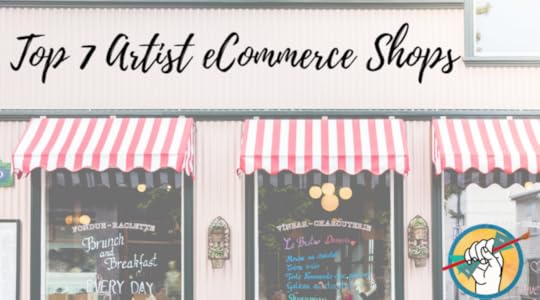
So what makes an artist eCommerce shop effective?
The site is easy to navigate. An interested customer should be able to figure out what you have for sale and how to purchase from you in 1-2 clicks. If your potential collector has to do too much work, they’re unlikely to make a purchase, even if they really like your stuff. The best artist ecommerce shops are easy to navigate and incredibly easy to buy from.
The branding is cohesive. The colors and fonts are consistent, and communicate a vision or evoke an intentional feeling that is consistent with the artist’s message or vision. (Some great examples of this below!)
The appearance is professional. Your art shop doesn’t have to be stuffy or plain, but it should be professional. Your images should be clear and sharp with links that work. All pages should have up-to-date information.
Top artist ecommerce shops
Jean Lurssen (Squarespace)
Jean Lurssen’s website homepage very clearly shows what kind of art is available, and the homepage doubles as gallery/shop. The instant the front page loads, you can see what is available and it’s fairly clear that the work is for sale (though you have to click through for pricing).
Takeaway: The site has a white background with minimal animation and a simple font that keeps your attention focused on the most important thing: the art.
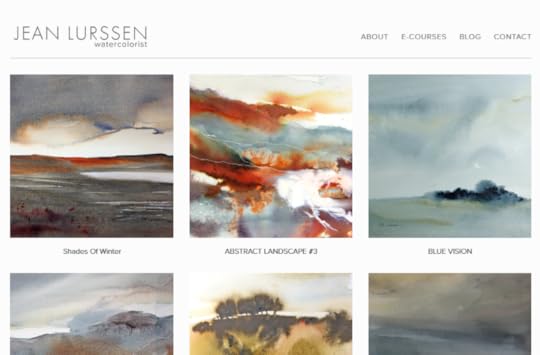
Amira Rahim (Shopify)
Amira Rahim’s site is an example of very solid branding. Her work is vibrant and colorful; a bright magenta plays a starring role in many pieces, and her logo, website header and header text reflects it. Multiple categories appear when you hover over Shop including Originals, Prints, and Recently Sold Works. When hovered over, each image in the shopshows the title, the medium and size, and the price. This is a very user friendly feature, because you don’t have to click over to a new page every time you want to see the price or the name of the piece.
Takeaway: Ease of navigation is key.
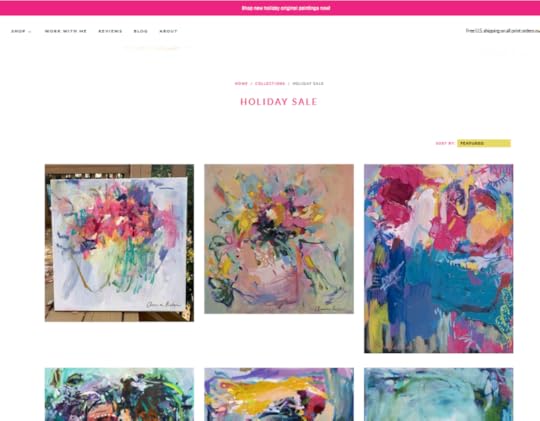
Emily Jeffords (Squarespace)
Emily Jeffords’ site features multiple shop tabs at the top including art gifts, originals, and prints. This is helpful for both customers who are just browsing and those who know exactly what they want. You don’t need to sift through tons of art you aren’t interested in purchasing. The site features a responsive design; hovering over an image shows an alternate perspective of each piece. The price is shown under each piece, so there is no clicking or even mouse hovering necessary. Clicking through to a piece shows a high quantity of images including the piece hanging on a wall, as well as closeups and views from different angles.
Takeaway: Providing as much visual information as possible to your potential collectors about the piece helps increase their confidence in buying.
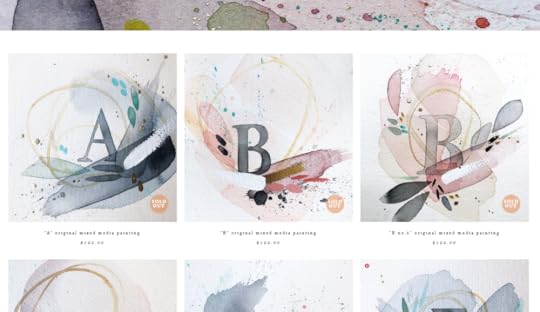
Amy Twon (WordPress)
Amy Twon leaves images of work that has already sold up in her shop with an icon indicating that they’re spoken for. This is a really effective strategy for invoking a sense of scarcity and fear of missing out in potential collectors without being dramatic.
Takeaway: Showing that you’ve sold many pieces already inspires confidence in your buyers.
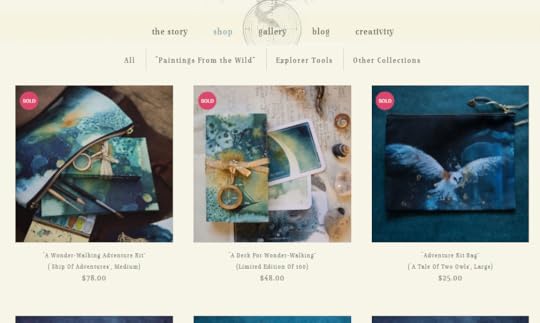
Matt LeBlanc (Shopify)
Matt LeBlanc sells art at a wide range of price points for every type of collector, so when you mouse over “Shop Originals” you can choose the price range you’d like to see. There is also a separate tab for accessories. Items on sale are marked, and items that are sold out are also marked- which as mentioned above, increases the sense of scarcity. The prices are shown beneath each image, and when an item is on sale the price is slashed to indicate what a good deal the buyer is getting.
Takeaway: Drawing attention to sale prices and making it easy for customers on a budget to enjoy your work is a good sales strategy once your business is established.
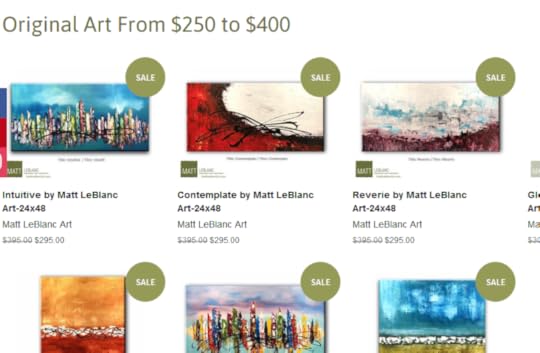
Kelly Rae Roberts (Divi for WordPress)
Kelly Rae Roberts is another artist whose website branding is on point. You can tell instantly what kind of art to expect from her before ever clicking on her shop page. On the left of the inventory is a menu where you can narrow your search by type. Clicking through shows a description of the piece and a drop-down menu where you can choose your print size and see the corresponding price. Kelly Rae also specifies in bold print that all shipping is always $7.
Takeaway: The combination of professional search functions and ease of navigation with a unique and memorable design ensures an enjoyable shopping experience.
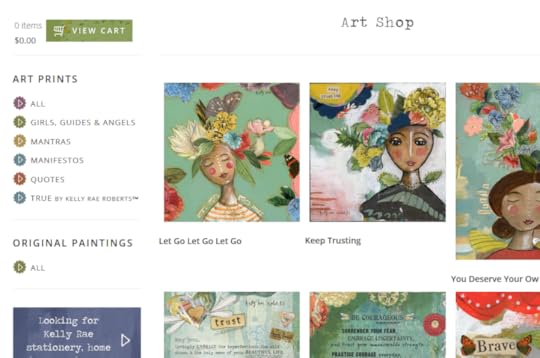
Marta Spendowska (Shopify)
Like many of the other shops on this list, products for sale are separated into originals, prints, and art gifts. You can then filter your search on the sidebar by color, product type, or collection which makes it easy to find exactly what you’re looking for. Hovering over each piece provides the piece title and the price so you don’t need to click through unless you want to see more details. Clicking through provides more images as well as several tabs with more details including materials, inspiration, and shipping information.
Takeaway: The amount of information available about each piece is a thoughtful touch that shows a high level of interest in the customer’s satisfaction.
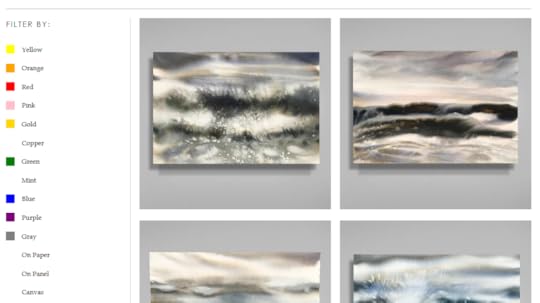
What do all of these shops have in common?
Each of the artist ecommerce shops in this list were included for their ease of navigating and purchasing, high level of professionalism, and careful branding and attention to detail. Your website doesn’t have to be ultra-slick with fancy responsive images and background videos, but the design and features should make it clear that you care about the customer’s experience and that you really do want to make the sale. If your ecommerce shop is thoughtfully designed, customers can focus less on trying to figure out how to make a purchase and more on which piece they want to buy first!
What do you think makes a great ecommerce shop? Let us know what’s important to you in the comments!
Need help with your website? Check out our affordable Artist Websites That Sell course, or see our list of recommended web designers.
The post Top 7 Artist eCommerce Shops appeared first on Online Marketing for Artists.
December 3, 2018
Productivity for Artists: Free Training
Last week we did one of the best free trainings I’ve ever done for artists. World-renowned productivity expert Charlie Gilkey joined me for 90 minutes of talking about what it means to be more productive and prolific.
It’s never been about churning out more crap to sell. Instead, our focus is on helping you use your time wisely, so you can make more art in the way that is best for you.
You can sign up to watch the replay at this link, or by clicking the image below.
We will have a full-text transcript of the webinar ready later this week.
In this webinar we covered:
Why creative, conceptualizing time is more important than actually putting paint to canvas or chisel to stone, and how to maximize this time even if you are an intuitive artist
Annual planning
Wayfinding: the process of figuring out where you are, where you want to go, and how to get there
How to use time blocking in a way that helps you maintain creative momentum
The difference between focus blocks, admin blocks, and when (not) to check your email
Why so many artists struggle to get more than a couple of big projects done a year
Check it for free at this link.
Links & resources mentioned in this webinar:
Learn how to implement everything we talked about in this webinar with Charlie’s class, Start Finishing Your Projects.
Time Blocking: http://www.productiveflourishing.com/time-blocking/
Why is Strategic Planning Hard for Creative People? http://www.productiveflourishing.com/strategic-planning-hard-creative-people/
Free Momentum Planners: http://www.productiveflourishing.com/free-planners/
A Frog a Day http://www.productiveflourishing.com/a-frog-a-day-keeps-your-anchors-aweigh/
Melissa Dinwiddie’s Creative Sandbox rules https://melissadinwiddie.com/creative-sandbox-rules/
The post Productivity for Artists: Free Training appeared first on Online Marketing for Artists.
November 28, 2018
How Art Challenges Can Improve Productivity
Have you ever sat down in the studio to create, and felt completely paralyzed by the number of decisions you had to make? In fact, no matter what kind of creator you are, a blank canvas (or a blank anything) can be incredibly daunting. Just like putting on your tennis shoes and driving to the gym is often the hardest part of a workout, getting started on a new piece of art is often the most difficult part of the whole process. Fortunately, there’s an easy way to overcome the obstacle of the blank page.
Just a month ago you may have logged onto Twitter or Instagram and been inundated with ink drawings by artists across the spectrum of styles and skill levels. They were taking part in #Inktober, a yearly art challenge that invites artists to create a new ink drawing every day for the entire month of October. They provide a list of single word prompts for each day , although not every artist uses the prompt list. Some choose to follow their own theme or be spontaneous each day.
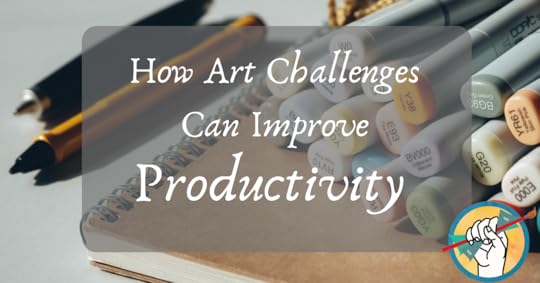
There are many, many art challenges out there for you to participate in. But why are art challenges useful? There are a few reasons why participating in an art challenge can help you improve your productivity:
Constraints remove the need to make decisions
Part of the difficulty with starting a new project is all the decision-making. Have you heard of decision fatigue? It’s a thing, and you’ve probably felt it at the supermarket when all you need is salad dressed, but you have to choose between 47 different varieties. It’s exhausting! Having to decide what to draw (or paint, or sculpt), what size to work in, what medium to use, how many pieces to make, can be so paralyzing that it’s difficult to get started. After all, what if you make the wrong choice? By the time you’ve settled, you may feel too mentally fatigued to focus all your energy on creating.
The constraints of an art challenge remove some, if not all, of the decisions you would normally need to make. #Inktober provides the medium (ink), the quantity of pieces (31) and prompts for each day. Less time making decisions = more time making art!
Art challenges are social
Internet art challenges almost always include a hashtag so you can tag your work and share it with everyone else participating. It’s fun and inspiring to see what other artists are doing within the challenge constraints. Its also a nice experience to participate in a large-scale activity with lots of other artists, and sharing that you’re participating and then posting your work regularly helps you stay accountable. Using a popular art challenge hashtag like #inktober can even earn you new followers.
The work you create during a challenge can inspire new projects and series
Though you may decide to participate in an art challenge simply for fun or as a warm up exercise, you may be surprised at what comes out. Many artists hang on to their challenge pieces and use those ideas later to fuel fully-realized projects, whether a series of paintings or a graphic novel.
How to create your own art challenge
This is the best part- you don’t have to wait for #Inktober to come around to enjoy the paradoxical freedom that setting constraints can provide. You can create your own challenge right now, and either invite other artists to join or simply embark on your own. You can decide on constraints that will help you to grow in areas you would like to explore or improve. The easiest formula is to choose a length of time, a medium, and a subject. Here are some ideas:
30 days of watercolor landscapes
14 days of painting animals in acrylics without using white paint
30 days of figure drawing directly with ink
You can take it further by providing yourself with a more specific prompt for each day, or just see where the inspiration of each new day takes you. Create a hashtag for your challenge, and begin sharing your pieces on social media and your blog. Not only is an art challenge great for breaking out of a rut and expanding your skills, but it’s a fun and engaging way to show up for your audience every day and keep them looking forward to the next day’s work. (It’s also a great use of your mailing list!)
Try these art challenges
Here is a list of art challenges to try out:
Inktober– a prompted ink drawing every day in October
The Sketchbook Project– Various sketchbook and print swap challenges throughout the year
Sketch Dailies– daily character drawing inspiration
Instagram challenges– here is a list of Instagram challenges you can use to inspire your art making. Use the hashtags to reach new eyes!
A Year of Creative Habits – Crystal Moody created art every day for 3 years and wrote about it. She also has a Facebook group you can join. We interviewed Crystal Moody here.
DailyPaintworks.com – if you want to try your hand at posting daily paintings for sale.
Have you ever participated in an art challenge? What did you learn from the experience?
The post How Art Challenges Can Improve Productivity appeared first on Online Marketing for Artists.
The Abundant Artist Goodreads blog
- Cory Huff's profile
- 31 followers


